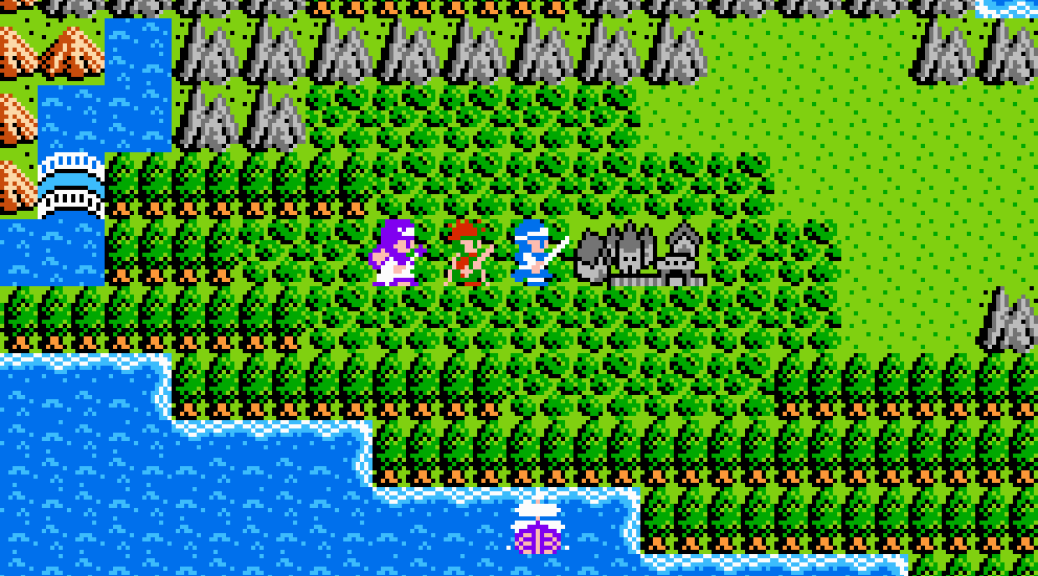Released: Jan 26, 1987
Version played: Switch Port (2019)
There’s one moment in Dragon Quest II that is so genuinely electric that it is, with no hint of exaggeration, genre-defining. The game has gone down in history as a somewhat awkward sequel and it certainly earns that reputation, replacing the original’s perfect yet simple minimalist recreation of the shape of computer RPGs with an attempt to build back up the scale and complexity in ways that leave the experience somewhat unbalanced. I am not going to argue that Dragon Quest II is better than the original. But the first Dragon Quest simply does not contain a single moment as powerful as when you finally unlock the boat.
It isn’t just that you can traverse the world map at greater speed and more easily; it isn’t even the boat itself. It is that the world transforms from a series of towns experienced largely in order to an interlocking puzzlebox of nodes and lines. Without the boat, you can generally do maybe one or if you’re lucky two optional tasks before moving on to the next town. You can go to the cave for the Silver Key. You can do the tombola before you meet the Princess. But you get the boat, and suddenly your next task is to gather five sigils from across the world, placed right in the path of your natural exploration.
This is absolutely an intentional moment of design but the trick is that it feels like you are getting one over on the game. You can go from saving up and scraping by to having all three keys, equipping multiple pieces of Erdrick Armor and a sizable warchest deposited in the treasury between mandatory dungeons. Dragon Quest II understands the motivation behind the average RPG player, the min-maxer, the grinder. What they are looking for is not mindless progression, but progression as reward for mindfulness. You pay attention to the world, the dialogue, the hints, the keys, your party’s strengths and weaknesses and for that you are rewarded with leaps in power that you can instantly feel.
And boy are you going to need them. Dragon Quest II is famously unbalanced, though it is much more approachable in the modern re-releases that you will almost certainly be playing now. But while the game is much softer there is only so much that could be done about the fundamental curve of the game’s progression. If the game’s high point is sailing free on the boat, the opening of the world into multiple regions replete with dungeons optional and mandatory, with dozens of different paths through depending on what breadcrumb trail you happen to follow first; then its low point is its endgame, where you simply have no choice but to walk back and forth fighting archdemons for a few levels.
It is remarkable how different Dragon Quest II feels from its predecessor considering it is, in one sense, literally the exact same game. The core loop is identical, the building blocks the same, but the increased scope and complexity radically change your interaction with the world and its systems. Dragon Quest was ultimately an adventure game wearing the clothes of an RPG, introducing RPG systems to a console audience mixing medicine with juice so your child can drink it. Dragon Quest II is a fucking dungeon crawler. You will be spending most of your time in dungeons, thinking actively at all times about resources, whether to engage in battle or risk running away, who to attack, who to defend, is this spell worth the cost, is this heal worth the cost, etc. etc. 1 v 1 fights over in seconds are replaced with battles where three party members go up against up to eight enemies at a time, not including possible reinforcements. The increased strategic depth is welcome but it also highlights a core tension that defines the genre to this day: the more time you spend in combat, the less time you spend exploring and feeling that sense of adventure. It is no coincidence that Dragon Quest II’s best moment is when you get a genuine extended break from all that exhausting dungeon crawling.
In the modern age there is a lot of discussion about turn based combat and whether it is “good,” but the difference between the first two Dragon Quest games draws attention to something I wish was discussed more in RPG and gaming spaces. Lots is often made of the simplicity/depth of a combat system, that is to say, how many active decisions are you making and what consequences do they have. And I want to be clear: I care a lot about that. I love playing games with complex and interlocking systems to dive into, rewarding mastery and providing opportunities for personal expression. But framing the discussion this way does place blinders on JRPG battles as aesthetic experiences, as punctuations in the rhythm of the greater whole. Dragon Quest II has better combat, that is to say, infinitely more depth than the none that its predecessor featured. But as a consequence far less time in Dragon Quest II is spent in the world, talking to NPCs, exploring towns and seeing what’s around the next corner. Dungeon runs become so routine that the towns themselves become merely extensions of the dungeon, places to rest and resupply, reduced to pure function simply because there is more function for them to fulfill. Dragon Quest is a sketch of a childhood idea of a fantasy story. Dragon Quest II is a video game.

